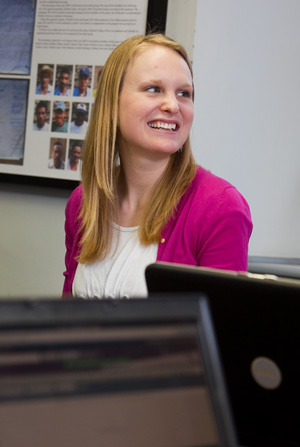Community Building in New Orleans
Jessalyn Rolwood ’10 writes about her work helping residents redevelop the Lower Ninth Ward as the first carbon-neutral community in the country
EASTON, Pa.(www.lafayette.edu), February 18, 2010 — Over winter break, civil engineering major Jessalyn Rolwood ’10 (Titusville, N.J.) and a group of five other students traveled to the Lower Ninth Ward of New Orleans to continue ongoing efforts to help the local community rebuild in a sustainable manner after the devastation caused by Hurricane Katrina. As part of the College’s Economic Empowerment and Global Learning Project (EEGLP), the students, led by David Veshosky, associate professor of civil and environmental engineering, met with representatives from numerous community groups.
“Once you’ve lived in New Orleans, there’s a certain inability to escape, even if you wanted to.” I was told this by many residents who we met and spoke with during our research-related trip in mid-January. After spending only a few days in the Big Easy, I began to understand why this is a common refrain for the locals. The city has a unique allure as the variety of cultures has created a flavor that is distinctly New Orleans.
Lafayette students and faculty are involved in a number of projects in New Orleans, particularly concentrated in the Lower Ninth Ward (L9W). The L9W is located on the eastern edge of the city and encompasses the Holy Cross and Lower Ninth Ward neighborhoods, which experienced the greatest devastation from Hurricanes Katrina and Rita. Our group, comprised of six students led by Professor Veshosky, had multiple goals for the visit. We hoped to present what we had accomplished in the last semester; receive feedback on our work; initiate new contacts and maintain established relationships with local organizations; and gain new information for the upcoming semester.
Our particular focus in the L9W is on sustainable repopulation and development. Pre-hurricane population levels for the area were estimated to be 17,000; today, the number is closer to 3,000. As people rebuild their homes and communities, the neighborhood’s Center for Sustainable Engagement and Development has committed to repopulate and develop with the least possible impact on the environment.
During the Fall 2009 semester, I worked with two other students and Professor Veshosky to develop an original carbon calculator specific to the current situation in the L9W. As we continue into the spring, we plan to use the calculator and other resources to perform “what if” analyses. For example, how will the carbon footprint of the neighborhood change if pre-Katrina population levels are reached? If homes and businesses “infill” rather than spread out? If a certain percentage of land is preserved as green space? If construction waste is reduced through smart building processes? We hope to provide the people of the L9W with a better grasp on the positive impact their community can have on the environment through their redevelopment decisions.
Visiting New Orleans was even more helpful than I expected. We were able to fulfill our original goals and actually added more into our busy schedule. In between meetings and presentations, there was time for exploring some of the city and having dinner with Lafayette alumni in the area. I learned a lot more through first-hand experiences in New Orleans than I could have by staying in Easton. I left New Orleans with a greater feeling of excitement for our project and a broader sense of community through working with the local organizations.
